Lecture #6 - Temporomandibular Joint
1/50
There's no tags or description
Looks like no tags are added yet.
Name | Mastery | Learn | Test | Matching | Spaced |
|---|
No study sessions yet.
51 Terms
The temporomandibular joint (TMJ) is a joint on
each side of the head that allows for movement of the mandible for mastication, speech, and respiration
A joint is
a site of junction or union between two or more bones
TMJ has its sensory innervation by…
V3 cranial nerve external carotid artery
The TMJ is the articulation of…
the temporal bone and the mandible
The temporal bone is
a cranial bone that articulates with the mandible at the TMJ by way of the joint disc
Temporal bone articulating area is on the…
squamous part
includes articular eminence and articular fossa
The articular eminence (aka articular tubercle)…
consists of a rounded protuberance the on the inferior aspect of zygomatic process
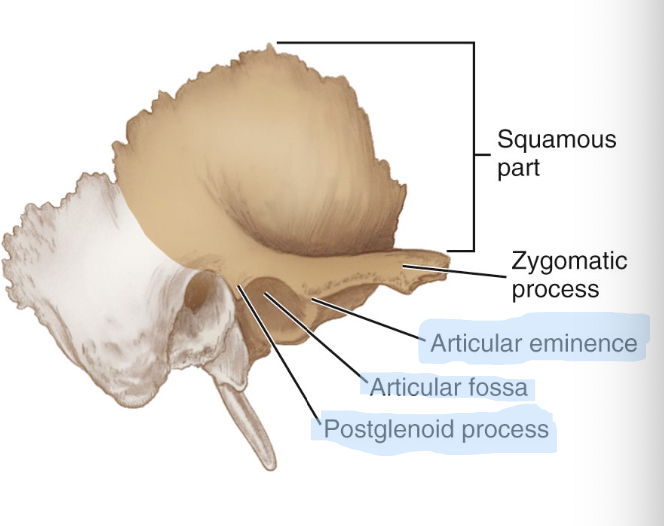
The articular fossa (aka glenoid/ mandibular fossa)…
is posterior to the articular eminence
consists of an oval-shaped depression on the temporal bone, which is posterior and medial to the zygomatic process of the temporal bone
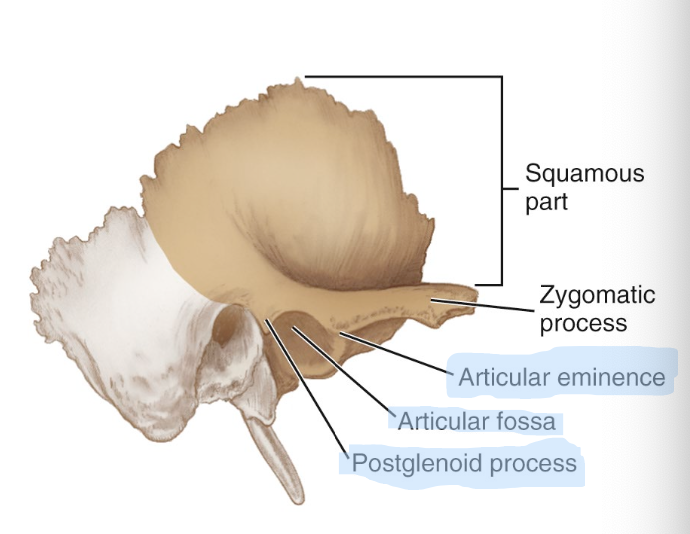
The postglenoid process
A sharp ridge posterior to the articular fossa
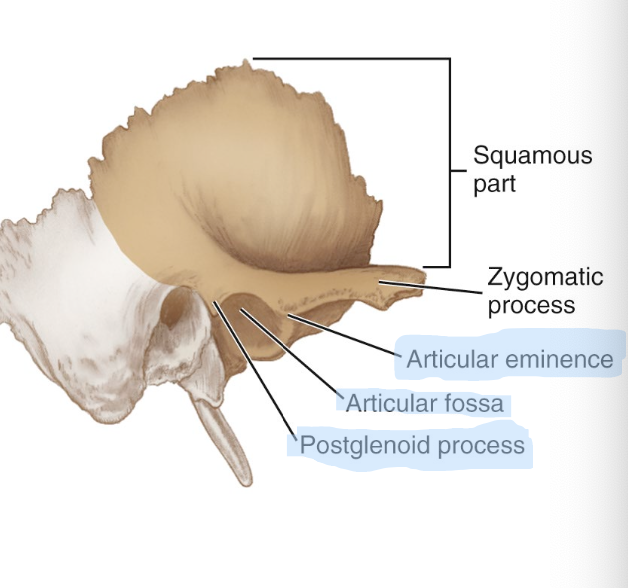
Mandible articulation is
The joint disc working with the knuckle-shaped posterosuperior process of the mandibular ramus
The head of this process is the mandibular condyle, and its superior surface is the articulating surface of the condyle
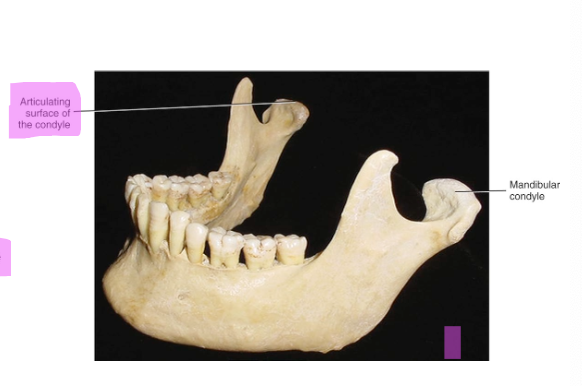
The articulating surface of the condyle is
strongly convex in the anteroposterior direction and only slightly convex mediolaterally
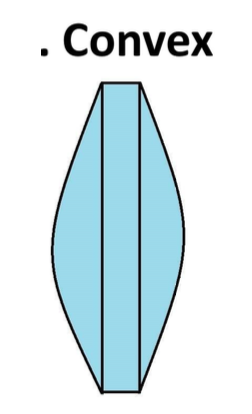
A fibrous joint capsule…
completely encloses the TMJ
The fibrous joint disc or meniscus is located…
between the temporal bone and mandibular condyle on each side, allowing articulation between the two bones
The joint disc is not attached to
the temporal bone anteriorly except indirectly through the joint capsule
Upper division of joint disc is
attached to the temporal bone’s post glenoid process
Lower division of joint disc is
attached to the neck of the condyle
The disc completely divides the TMJ into two compartments or synovial cavities:
the upper and lower synovial cavities
The membranes lining the inside of the joint capsule secrete
synovial fluid that helps lubricate the joint and fills the synovial cavities
A ligament is
a band of fibrous tissue that connects bones
The mandible is joined to the cranium by
Three paired ligaments are associated with the TMJ:
1) temporomandibular ligaments
2) stylomandibular ligaments
3) sphenomandibular ligaments
The TMJ ligament prevents
the excessive retraction or moving backward of the mandible
The stylomandibular ligament runs from
the styloid process of the temporal bone to the angle of the mandible
it becomes taut when the mandible is protruded
The sphenomandibular ligament is not strictly considered
part of the TMJ but is located on the medial side of the mandible, at some distance from the joint
The TMJ allows for the movement of the mandible during
speech and mastication by way of each muscle attached to the cranium and mandible
There are two basic types of movement performed by the TMJ joint and its associated muscles:
1) gliding (or sliding)
2) rotational (or hinge) movements
The gliding movement of the TMJ occurs mainly between the
disc and the articular eminence of the temporal bone in the upper synovial cavity, with the disc plus the condyle moving forward or backward, and down and up the articular eminence
The gliding movement allows the lower jaw to
move forward or backward
Bringing the lower jaw forward involves
protrusion of the mandible
Protrusion involves the bilateral contraction of both of the…
lateral pterygoid muscles
Lateral Pterygoid muscles: Origin
sphenoid (both the superior head and inferior head)
Lateral Pterygoid muscles: Insertion
Both heads - neck of mandibular condyle
Superior head - TMJ capsule
Bringing the lower jaw backward involves
retraction of the mandible
The contraction of the posterior parts of both ________ are involved during retraction of the mandible
temporalis muscles
Temporalis Muscles: Origin
Temporal fossa
Temporalis Muscles: Insertion
coronoid process of mandible
Temporalis Muscles: Action
elevate & retract mandible
The rotational movement of the TMJ occurs mainly between the
disc and the mandibular condyle in the lower synovial cavity
The axis of rotation of the disc plus the condyle and their movements accomplish the depression or elevation of the mandible
Depression of the mandible
is the lowering of the lower jaw
Elevation of the mandible
is the raising of the lower jaw
The muscles of mastication involved in elevating the mandible during closing of the jaws include the
bilateral contractions of the masseter
temporalis
medial pterygoid muscles
Clinical note: Temporomandibular Disorder (TMD)
The patient may experience chronic joint tenderness, swelling, and painful muscle spasms.
Also present may be difficulties of joint movement such as a limited or deviated mandibular opening
Crepitus describes
any grinding, creaking, cracking, grating, crunching, or popping that occurs when moving a joint
Internal Problems of the TMJ: Sounds (Popping and Clicking)
Popping or clicking occurs when the disk is pulled too far forward when opening.
Posterior band gets caught between the head of the condyle and the articular eminence.
The band may pop forward or posteriorly, makes a reciprocal popping sound.
Possible that the sound will be too faint to hear, but can be felt on palpation
Frequently visible if only a problem on one side
Treatment includes ultrasonography, physical therapy, and plastic splint
Internal Problems of the TMJ: Sounds (Disk Derangement)
Constant anterior displacement of the disk leads to permanent damage to the disk components
Requires surgery
Internal Problems of the TMJ: Subluxation
When a person opens his or her mouth too wide and cannot close it or when closing causes popping
When the condyle glides too far forward and moves anterior to the articular eminence
Condyle cannot reposition in its proper place.
Possible causes:
Depth of condylar fossa and height of articular eminence
Treatment is surgery to decrease the height of the articular eminence
Internal Problems of the TMJ: Bruxism
Tooth grinding
Usually during sleep
Creates tenderness in the TMJ area
Muscles of mastication become tired, but pain is felt in the joint.
Treatment: plastic night guard that covers the upper teeth
Eliminates wear on teeth and tenderness of teeth from stress on the periodontal ligamen
Internal Problems of the TMJ: Arthritis and Other Pain
Cortisone can relieve arthritis but pain remains a problem.
Some patients report a grinding sensation in the joint.
Might be the result of excessive wear on the disk
Occlusal surfaces wear away over time which leads to TMJ pain.
Rebuilding teeth to original height eases the pain
Most pain is actually not in the joint but in muscles
Not all patients with TMD have
abnormalities in the joint disc or the joint itself
Most symptoms seem to originate from the muscles supporting the joint
With TMD, when the patient tries to close and elevate the mandible, the condylar heads cannot move posteriorly because the muscles of mastication have become spastic…
The patient now has trismus, which refers to reduced opening of the jaws
Trismus can also occur with odontogenic infections
Can also from an inferior alveolar nerve block injection
Most cases of TMD improve over time with inexpensive and reversible conservative treatments, including…
patient-based or prescription pain control, relaxation therapy, stress management, habit control, moderate muscle exercises, and orofacial myology
Clinical Note: Myofascial Pain Dysfunction (MPD)
increased pain at the TMJ due to muscle tension and spasm
Believed that it is a physical manifestation of psychologic stress.
No primary disorder of the joint itself is present